Fully loaded Surly Troll in a semi-bikepacking setup in Tolhuin, Tierra del Fuego, Argentina in March 2017.
Bike and bags
Built around a 18″ Surly Troll frame. Tyre clearance in the rear up to 2.8″ (respectable for pre-plus-bikes era) and up to 3″ in the front. Currently running 2.5″ Surly ET’s WTB Ranger Tough 2.8″s on WTB Scraper i40 rims. Tubeless. Carried a conventional carrying system (four panniers) from Finland to Indonesia, for South America made a transformation to soft bags to get lighter. The bike was built to have close to the same saddle-to-bar drop and reach as my other drop bar bikes.
Seat bag, accessory pack and handlebar roll by Ortlieb. Zipperless frame bag self designed, co-produced with a friend. Arkel Dry-Lite panniers and Alpkit toptube bag and stem bags (a big one and a water proof one). No backpack.
Current dry weight by an airport scales: 18kg (bike and front rack) + 12 (bags and gear) = 30kg.
Carries up to 10 litres of liquid and up to one weeks one months (!) simplified food with semi cold climate (max -15 Celsius) gear.
Bike and bags Updates (!)
I have done rather big changes for the setup during the first year in South America. Got rid off all the gear not absolutely essential for survival (except fly fishing gear!), I modified my Surly Nice Front rack to cut off 500g of weight, Orlieb handlebar roll was replaced by self-made vertical dry bag harness and petrol stove replaced my winter adjusted alcohol stove. Additionally I updated my rim width from 29mm to 40mm and tire size from 2.5″ to 2.8″ with the support of Wilderness Trail Bicycles.
Hobo-cross loaded with 17.5kg of food and fuel and 10 litres of water in Guandacol, Argentina, in January 2018.
SURLY TROLL “HOBO CROSS”
| FRAME AND FORK: | Surly Troll 18″ |
| REAR HUB: | Rohloff Speedhub QR 500/14 |
| FRONT HUB: | Shutter Precision SP PD-8 dynamo |
| RIMS: | WTB Scraper i40 |
| SPOKES: | Unknown |
| TIRES: | WTB Ranger Tough Fast Rolling 2.8″ |
| TUBES: | – |
| CRANKSET, BOTTOM BRACKET: | Shimano SLX, some emergency Shimano |
| CHAIN: | KMC X8-93 |
| CHAINRING: | Surly 32t |
| COG: | Rohloff 19t |
| PEDALS: | Shimano A530 |
| FRONT RACK: | Surly Nice Front Rack (heavily modified) |
| BRAKES: | Avid BB7 |
| BRAKE LEVERS: | Old Shimano 105’s |
| HANDLE BAR: | FSA Vero 42cm |
| SEAT POST: | Long Straight Thomson |
| STEM: | System X 35 degree 110mm |
| BOTTLE CAGES: | Salsa Anything Cage + 2x Salsa Nickless Cage |
Sleeping and shelter
I like riding in cold climates and I have a history of getting the season wrong on a long bike tour , so I am still carrying a rather wintery sleeping system by Thermarest, Sea to Summit, and Rab. I can sleep comfortably down to -10C with my current mattress (Thermarest XTherm, R=4.7) and sleeping bag (Sea to Summit Talus II, fill weight 600g, water resistant down, full length zipper) and down jacket (Rab Infinity Endurance, fill weight 250g, water resistant down). I have built attachment points to connect the down jacket on the sleeping bag when night temperatures drop below -5C. Colder than -10C and I would use a second down jacket (what ever I can find locally) as a ‘sock’ on the feet part of the sleeping bag. Tent is a light and storm proof one layer tarp tent (Lunar Solo by Six Moon Designs, 750g with pegs and pole). Always fresh air inside, light, dries quickly and packs small. Drawbacks are condensation and inability to carry snow loads.
I believe I have nearly the best possible sleeping system available for my needs. I love the modularity and low weight. Cost wise especially the sleeping bag is extremely good value as well.
Comment:
I started my trip with my 7 year old beautiful winter bag, but it failed me in the cold wet climate. Day by day the volume diminished in the early Scandinavian winter. I swapped only three weeks into my trip to a rather similar bag made of water resistant down and it made all the difference. Solved all my problems with my sleeping system. Does not gather humidity much at all and dries rather quickly.
Where?
Tent and sleeping bag are in a big dry bag, which is strapped on the front rack. Mattress is in a pannier, but is a perfect fit to the large stem bag too, if more space in the pannier is needed. Down jacket is in the seat pack, quickly accessa
Cooking and water
Edit 20.4.2018:
A complete cooking system revision in August 2017. Sold my petrol stove and built a winter adjusted alcohol stove from a beer can. In Patagonia I started to cook nearly always on fire, so carrying the weight of the petrol stove did not feel justified anymore. So far I have been extremely pleased with the change, my modified Penny stove works brilliantly at high altitude and below zero temperatures.
My old PRIMUS Himalay Multifuel stove from 1991 still works well, so I am still having it with me for cold weather and high mountains. It is on the heavy side, but the stove with the full metal pump is extremely reliable. 0.5L petrol bottle. This piece of history just about fits in the 1.2L pot (no-name from Poland from 90’s), which is flat enough to fit into my frame bag. Cutlery are a spoon and chop sticks. I am having a 600ml cup too for mate and wine, bought which I can use for boiling water too. For water treatment I mostly use cleaning pills, but when from a natural source I filter the water with Sawyer Mini. For carrying additional water for the 4.5 litres I can carry in the cages, I have two one 2 litre bladders by Platypus. Edit 5.6.2017: In Patagonia I am also carrying an extra 250ml of petrol in a small Coke bottle. Though I have got into habit of cooking on fire, when ever possible.
Where?
All the kitchen stuff is in the frame bag. Water purification and filtering system is in the fuel bag on the top tube. 600ml cup hangs on the seat bag.
Clothing
I can dry nearly all my clothing by wearing them while cycling. Tested spending the winter 2014-2015 touring in rainy and cold Europe. When the day time temperatures are above 0 Celsius, this is what I carry:
- Two thin merino t-shirs, one short sleeve and one long sleeve, both Devold Breeze -series
- Thin long johns (will swap to merino ones eventually as well) by Halti, had them for nearly 10 years!
- A thin fleece (insulating merino would dry too slowly!) by Halti, had it for nearly 10 years!
- Cycling pants Endura Hummvee (had them for over 5 years!) and rain paints Endura Superlight
- 3x thin merino boxers and socks
- Grandma’s wool socks
- Rain jacket Outdoor Research Helium II (light, good value and fully featured with pit zips!)
- Down jacket Rab Infinity Endurance (fill weight 250g, water resistant down, expensive, but the best)
When the day time temperatures drop below -5 Celsius a second pair of long johns and a second thin fleece are necessary. Insulated cycling shoes become a necessity too. These I am not carrying and try to source them locally, like I did in Tajikistan and China in 2015.
Where?
Most of the clothing is stored in the seat pack. What I could need daily, like rain gear and the gile, are in a small blue drybag in the front.
Accessories
- Cycling cap of BC Hellsinki
- Sun hat
- Gloves by SIMMS (stays warm when wet, dries fast, great for regulating heat)
- Big no name mittens to be used on the gloves in long downhills in winter and at high altitude
- A day beanie and a night beanie
- 3x Merino wool balaclava
Where?
Panniers and the blue small dry bag in the front.
Footwear
- Cycling shoes Sidi Dragon 3
with toe guards. - Sandals
by KEENsimilar to KEENs (sturdy enough for trekking too) - Thick neoprene overshoes by Shimano for rain and below 5C temperatures.
Where?
Sandals are on the front rack. Overshoes on the seat pack when not in use.
Toiletries and medical kit
Very basic stuff, mentioning only a couple maybe more special here:
- Stuff for proper wound cleaning and stiching
- Antibiotics, a couple of different kinds
- Wet wipes, great for cleaning the chain and oily hands too (!)
- A beard comb
Where?
The toilet bag is stored in a pannier. The emergency kit in the back of the seat pack.
Repairs and tools
All the tools to take the bike apart, except the bottom bracket wrench and the Rohloff cog tool. Pump is the reliable full aluminium Lezyne MiniDrive.
Bike spares:
- A couple of brake pads
- Two tubes
- 5 cm of chain
- Chain oil
- Zip ties and duck tape
- Patches for side wall tear
- Normal tube patches
No spare cables, hoses or tyre anymore.
Other spares and repair stuff:
- Thermarest quick fix patches
- New soul pads for cycling shoes
- Spare hose for the Lezyne MiniDrive pump
- Silicone glue for tent repairs (fly sheet is made of silicone nylon)
- Polyurethane glue Liquisole for bag repairs. Makes a permanent seal for Ortlieb bags!
Where?
Tools and a tube on the bottom of the frame bag, under the kitchen stuff. Repairs are in a pannier.
Electronics
- Camera Fujifilm X100 with a lens extension (35mm and 50mm) + 4x battery + charger
- External hard rive
- Memory stick
- Apple MacBook Air 11″
- Apple iPhone 6+
- Kindle
- 5000 mAhPower Bank, charged from the dynamo, 8000 mAh as a backup too
- Head torch
Led Lenser H6R (USB -rechargeable)a local cheap one after Led Lenser broke - Dynamo powered front light Busch and Müller Lumotec IQ-X and rear light Toplight Line Small
- Voltage converter Busch and Müller E-Werk, Cache Battery by Busch and Müller too.
- A couple of micro-USB cables, iPhone charging cable and two USB wall chargers
Where?
Camera, lenses, the big phone and the memories are in the Ortlieb accessory bag. Laptop and eBook in a pannier.
Many long distance tourers have got their dynamo charging system faulty after a couple of months exposure to the elements, I am trying to avoid that. I have dedicated my waterproof stem bag for the dynamo voltage converter, some cables and the power bank.
Fly fishing gear
- No name 6wt 7 piece rod, smallest packing found in 2014.
- Reel VISION Flyfishing Rulla
- Floating line VISION Flyfishing Vibe 85 #6
- Different size and type of leaders
- 1 full box of flies from dry flies to pike flies
- A bit of lead
Where?
The 7 piece rod fits beautifully in the seat bag, exactly the same length as my tent pole, which is stored in the seat pack as well. Other fishing stuff is in a pannier.
Others
- Leatherman Multitool
- Sun glasses & Clear glasses
- Tiny cable lock
- Fake wallet
- Real wallet
- Sun screen
Where?
These are stored in the top tube bag and the accessory bag.

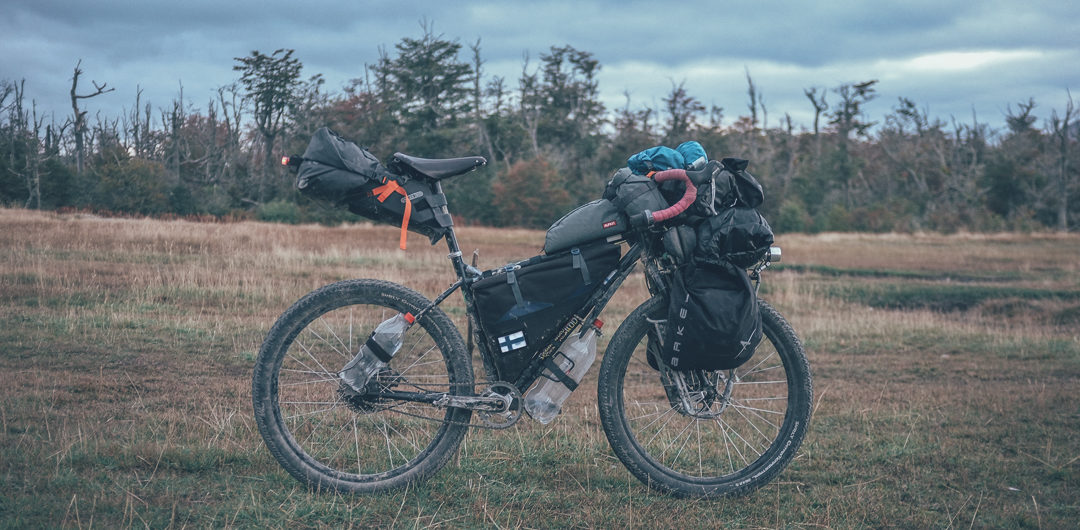
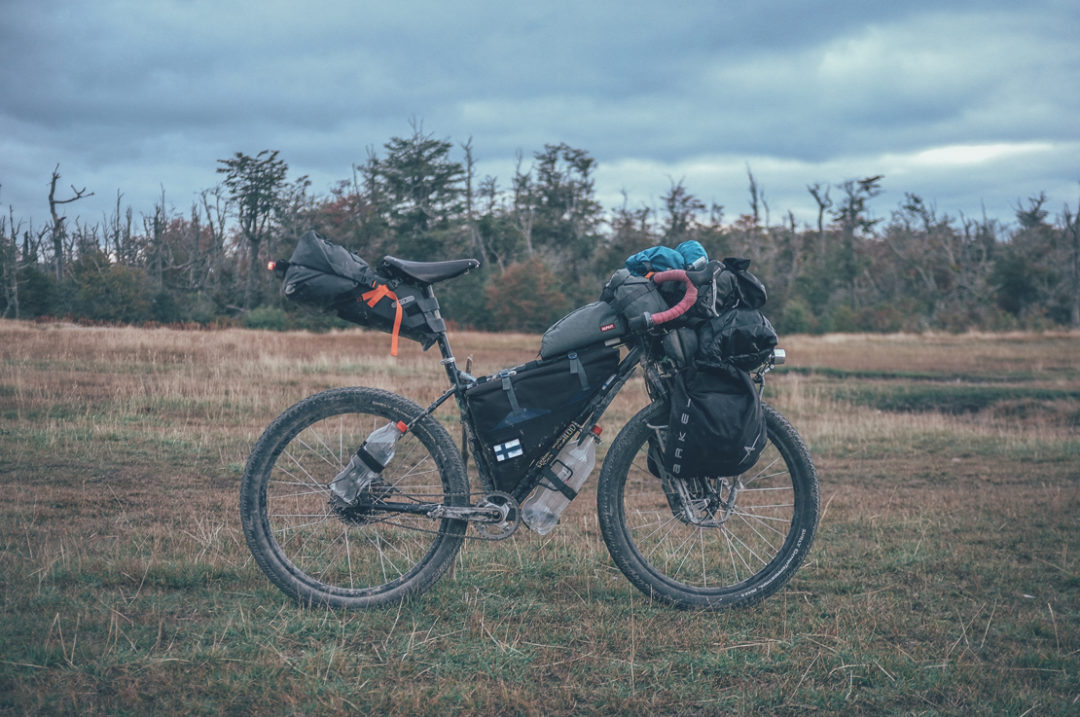
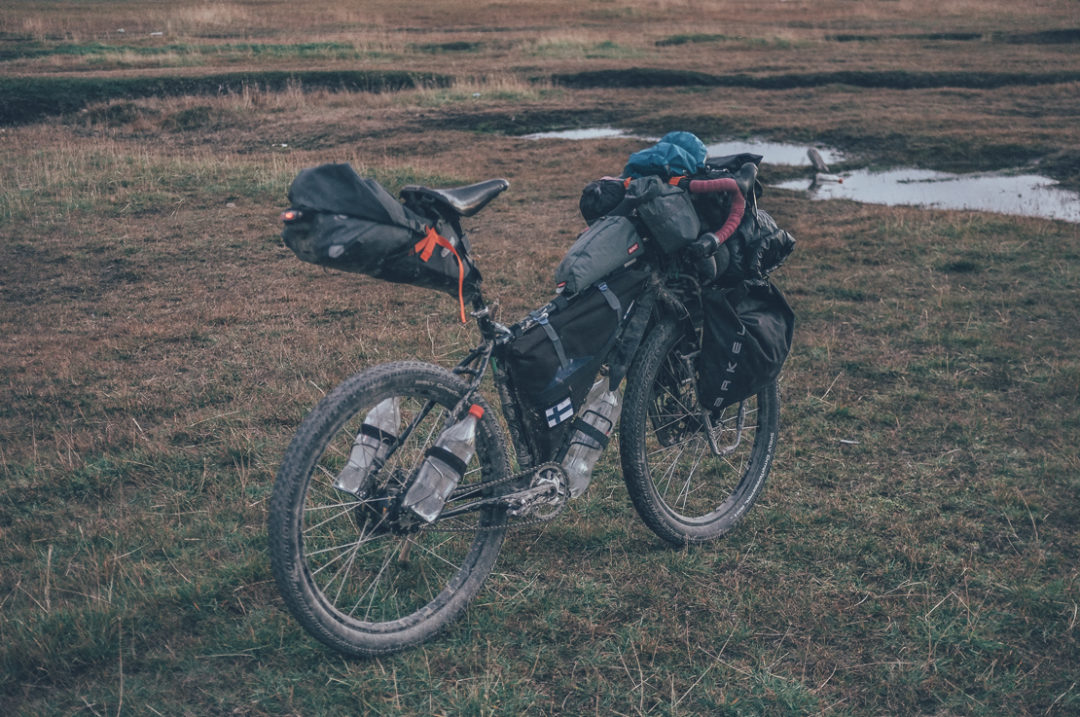
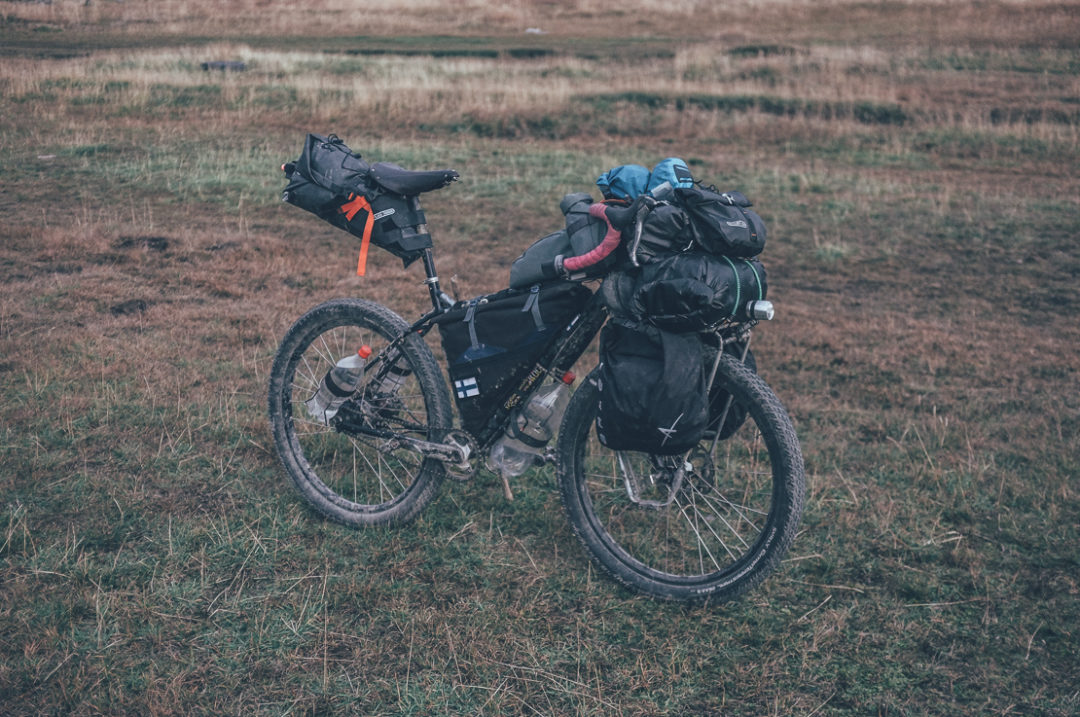
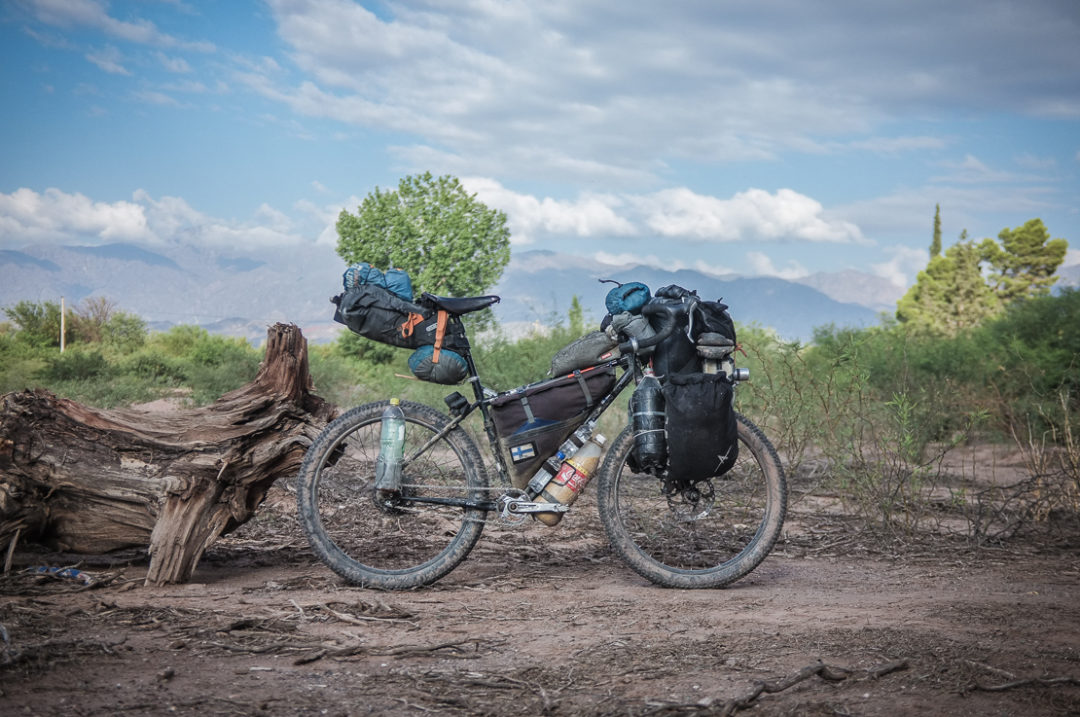
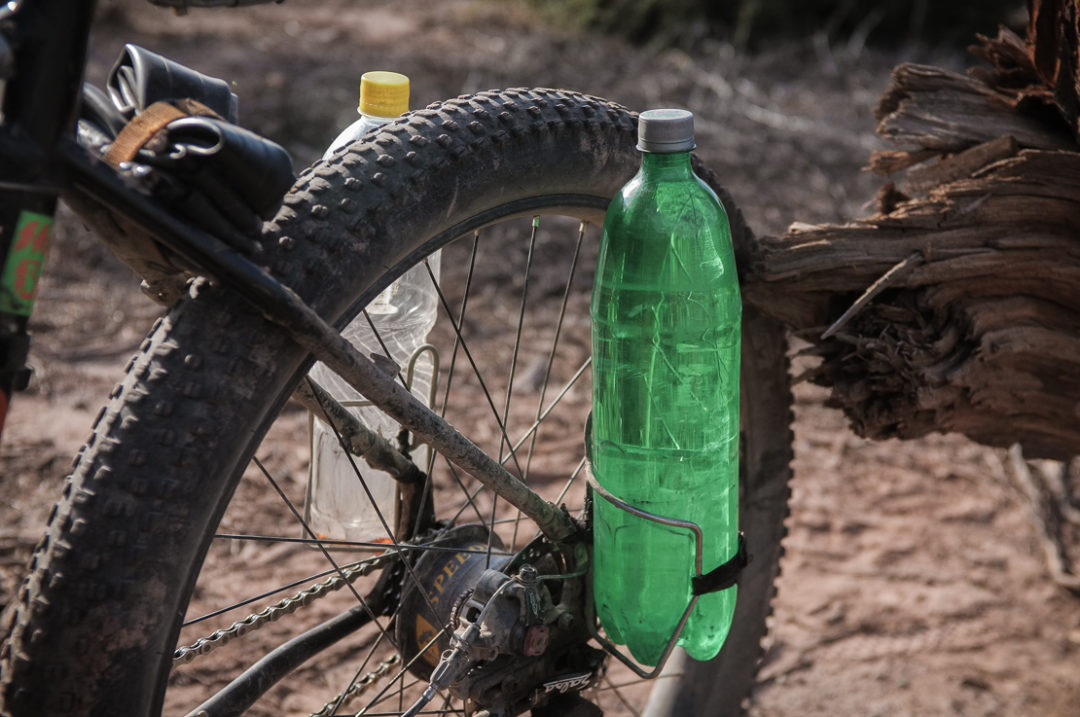
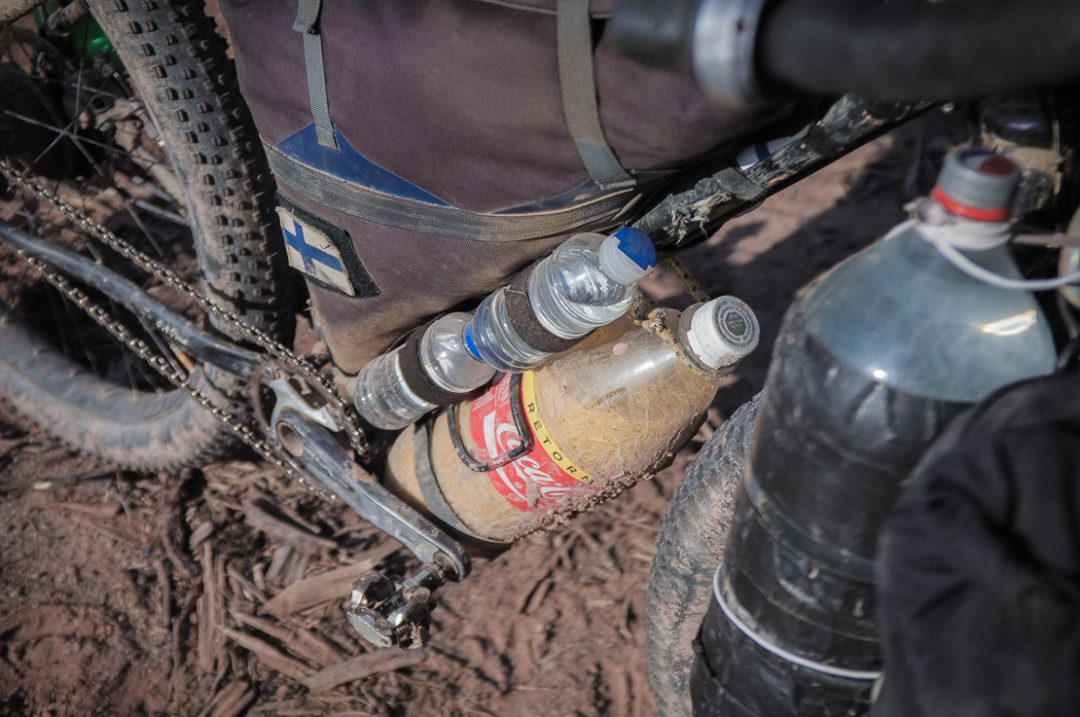
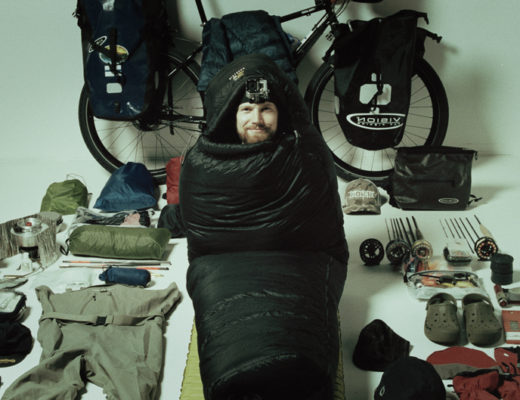
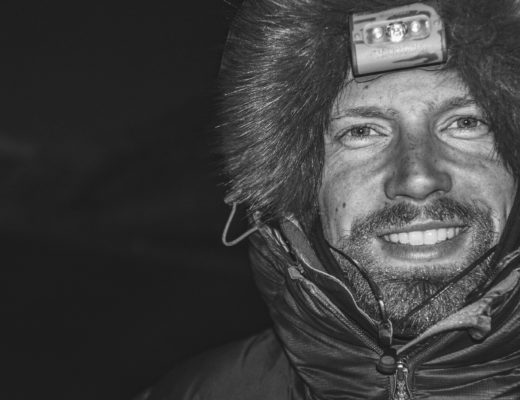
solo bikepacker
April 1, 2017 at 12:54 pminteresting setup .. the sandals can be changed out for https://fyf.io save space been using them for pass few months love them
Taneli
April 1, 2017 at 5:44 pmThe barefoot sock shoes, or whatever they are, look awesome!
Vicente Siufi
April 11, 2017 at 12:50 amVery crazy, very minimalist! The more details, the best hehe
I’m almost ready to star my biketour and I have choosen some bike parts just like yours… 26er, rohloff, 110mm and 35º at the stem… but I’m going on tubus and MSX panniers and Ortilieb handlebar bag.
Could you give me and adivice about the gear? How light does it need to be using 2.0 tires and fully loaded.
Thanks and congrats!
Taneli
April 15, 2017 at 6:23 pmHola from Puerto Natales, Chile!
Sounds like a pretty solid setup you are going for!
In my experience, mid wide tires like 2.15 Mondials work really well with a heavy load (equals to weight of the bike, gear food and water reaching up to 50kg) on rather smooth gravel roads and pavement. Just pumped them up to the rim maximum and they still roll pretty fast. I was carrying a pressure gauge to ensure that I had the lowest possible rolling resistance when on paved surfaces. More over they have a greater life span than narrower similar tires. On rougher roads and single track? You have the option to lower the pressure and stay still relatively comfortable. Though the long lasting touring tires like Mondials tend to be slow when used on lower pressures, and it is still just a 2.0 tire, which going for rougher gravel roads, double tracks and trails would be rough going.
In short you don’t need to be light to go with 2.0 tires. If you are heavy, bigger tires would actually prevent some wheel issues and more volume bumpers the impacts. Will make you more comfy as well. They would definitely make you slower on paved roads if you do not take care of the correct tire pressure though.
Cheers,
Taneli
Vicente Siufi
May 8, 2017 at 12:21 amThanks for the analysis!
I have to admit that I’m not in love with Mondial out of paved roads… and yeah, I agree that bigger tires must be better for heavy loads, but my clearance doesn’t allow much more.
Thanks for all and good luck at the road!
Taneli
May 9, 2017 at 6:31 pmYou are welcome! I agree with you that anything else than hard packed gravel Mondials are not the best choice. Tailwinds!